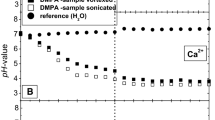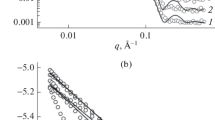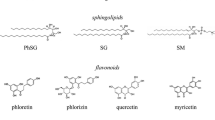Abstract
The dipole potentials, ψ d, of phospholipid vesicles composed of pure dimyristoylphosphatidylcholine (DMPC) or vesicles in which 50 mol% of the DMPC was substituted by dimyristoylphosphatidylserine (DMPS), dimyristoylphosphatidylglycerol (DMPG), dimyristoylethanolamine (DMPE), dimyristoylphosphatidic acid (DMPA) or monomyristoylphosphatidylcholine (MMPC) were measured via a fluorescent ratiometric method utilizing the probe di-8-ANEPPS. The PS and PG headgroups were found to cause only minor changes in ψ d. PE caused an increase in ψ d of 51 mV. This could be explained by a decrease in the dielectric constant of the glycerol backbone region as well as a movement of the P−–N+ dipole of the less bulky PE headgroup to a position more parallel to the membrane surface than in PC. The negatively charged PA headgroup increases ψ d by 215 mV relative to PC alone. This indicates that the positive pole of the dipole predominantly responsible for the dipole potential is located at a position closer to the interior of the membrane than the phosphate group. The increase in the charge of the negative pole of the dipole by the phosphate group of PA increases the electrical potential drop across the lipid headgroup region. The incorporation of the single chain lipid MMPC into the membrane causes a decrease in ψ d of 142 mV. This can be explained by a decrease in packing density within the membrane of carbonyl dipoles from the sn-2 chain of DMPC. The results presented should contribute to a better understanding of the electrical effect of lipid headgroups on the functioning of membrane proteins.


Similar content being viewed by others
References
Alakoskela JMI, Kinnunen PKJ (2001) Control of a redox reaction on lipid bilayer surfaces by membrane dipole potential. Biophys J 80:294–304
Alakoskela JMI, Söderlund T, Holopainen JM, Kinnunen PKJ (2004) Dipole potential and head-group spacing are determinants for the membrane partitioning of pregnanolone. Mol Pharmacol 66:161–168. doi:10.1124/mol.104.000075
Brockman H (1994) Dipole potential of lipid membranes. Chem Phys Lipids 73:57–79. doi:10.1016/0009-3084(94)90174-0
Cevc G (1993) Thermodynamic parameters of phospholipids. In: Cevc G (ed) Phospholipids handbook. Marcel Dekker, New York, p 939
Cladera J, O’Shea P (1998) Intramembrane molecular dipoles affect the membrane insertion and folding of a model amphiphilic peptide. Biophys J 74:2434–2442
Cladera J, Martin I, Ruysschaert JM, O’Shea P (1999) Characterization of the sequence of interactions of the fusion domain of the simian immunodeficiency virus with membranes. J Biol Chem 274:29951–29959. doi:10.1074/jbc.274.42.29951
Cladera J, O’Shea P, Hadgraft J, Valenta C (2003) Influence of molecular dipoles on human skin permeability: use of 6-ketocholestanol to enhance transdermal delivery of bacitracin. J Pharm Sci 92:1018–1027. doi:10.1002/jps.10344
Clarke RJ (1997) Effect of lipid structure on the dipole potential of phosphatidylcholine bilayers. Biochim Biophys Acta 1327:269–278. doi:10.1016/S0005-2736(97)00075-8
Clarke RJ (2001) The dipole potential of phospholipid membranes and methods for its detection. Adv Colloid Interface Sci 89–90:263–281. doi:10.1016/S0001-8686(00)00061-0
Clarke RJ, Kane DJ (1997) Optical detection of membrane dipole potential: avoidance of fluidity and dye-induced effects. Biochim Biophys Acta 1323:223–239. doi:10.1016/S0005-2736(96)00188-5
Clarke RJ, Lüpfert C (1999) Influence of anions and cations on the dipole potential of phosphatidylcholine vesicles: a basis for the Hofmeister effect. Biophys J 76:2614–2624
Gawrisch K, Ruston J, Zimmerberg J, Parsegian VA, Rand RP, Fuller N (1992) Membrane dipole potentials, hydration forces, and the ordering of water at membrane surfaces. Biophys J 61:1213–1223
Gross E, Bedlack RS Jr, Loew LM (1994) Dual-wavelength ratiometric fluorescence measurement of the membrane dipole potential. Biophys J 67:208–216
Haydon DA, Myers VB (1973) Surface charge, surface dipoles, and membrane conductance. Biochim Biophys Acta 307:429–443. doi:10.1016/0005-2736(73)90289-7
Hladky SB, Haydon DA (1973) Membrane conductance and surface potential. Biochim Biophys Acta 318:464–468. doi:10.1016/0005-2736(73)90211-3
Hunter GW, Squier TC (1998) Phospholipid acyl chain rotational dynamics are independent of headgroup structure in unilamellar vesicles containing binary mixtures of dioleoyl-phosphatidylcholine and dioleoyl-phosphatidylethanolamine. Biochim Biophys Acta 1415:63–76. doi:10.1016/S0005-2736(98)00178-3
Kinosita K Jr, Kawato S, Ikegami A (1984) Dynamic structure of biological and model membranes: analysis by optical anisotropy decay measurement. Adv Biophys 17:147–203. doi:10.1016/0065-227X(84)90027-3
Klauda JB, Kučerka N, Brooks BR, Pastor RW, Nagle JF (2006) Simulation-based methods for interpreting X-ray data from lipid bilayers. Biophys J 90:2796–2807. doi:10.1529/biophysj.105.075697
Lewis BA, Engelman DM (1983) Lipid bilayer thickness varies linearly with acyl chain length in fluid phosphatidylcholine vesicles. J Mol Biol 166:211–217. doi:10.1016/S0022-2836(83)80007-2
Liberman YA, Topaly VP (1969) Permeability of biomolecular phospholipid membranes for fat-soluble ions. Biofizika 14:452–461
Maggio B (1999) Modulation of phospholipase A2 by electrostatic fields and dipole potential of glycosphingolipids in monolayers. J Lipid Res 40:930–939
Mashl RJ, Scott HL, Subramaniam S, Jacobsson E (2001) Molecular simulation of dioleoylphosphatidylcholine lipid bilayers at differing levels of hydration. Biophys J 81:3005–3015
Pearson RH, Pascher I (1979) The molecular structure of lecithin dehydrate. Nature 281:499–501. doi:10.1038/281499a0
Pickar AD, Benz R (1978) Transport of oppositely charged lipophilic probe ions in lipid bilayer membranes having various structures. J Membr Biol 44:353–376. doi:10.1007/BF01944229
Rand RP, Parsegian VA (1989) Hydration forces between phospholipid bilayers. Biochim Biophys Acta 988:351–376
Schamberger J, Clarke RJ (2002) Hydrophobic ion hydration and the magnitude of the dipole potential. Biophys J 82:3081–3088
Seelig J, Macdonald PM, Scherer PG (1987) Phospholipid head groups as sensors of electric charge in membranes. Biochemistry 26:7535–7541. doi:10.1021/bi00398a001
Semchyschyn DJ, Macdonald PM (2004) Conformational response of the phosphatidylcholine headgroup to bilayer surface charge: torsion angle constraints from dipolar and quadripolar couplings in bicelles. Magn Reson Chem 42:89–104. doi:10.1002/mrc.1333
Shinoda W, Shimizu M, Okazaki S (1998) Molecular dynamics study on electrostatic properties of a lipid bilayer: polarization, electrostatic potential, and the effects on structure and dynamics of water near the interface. J Phys Chem B 102:6647–6654. doi:10.1021/jp9814808
Smaby JM, Brockman HL (1990) Surface dipole moments of lipids at the argon-water interface. Similarities among glycerol-ester-based lipids. Biophys J 58:195–204
Starke-Peterkovic T, Turner N, Else PL, Clarke RJ (2005) Electric field strength of membrane lipids from vertebrate species: membrane lipid composition and Na+-K+-ATPase molecular activity. Am J Physiol Regul Integr Comp Physiol 288:R663–R670. doi:10.1152/ajpregu.00434.2004
Visser NV, van Hoek A, Visser AJWG, Frank J, Apell H-J, Clarke RJ (1995) Time-resolved fluorescence investigations of the interaction of the voltage-sensitive probe RH421 with lipid membranes and proteins. Biochemistry 34:11777–11784. doi:10.1021/bi00037a015
Vitha MF, Clarke RJ (2007) Comparison of excitation and emission ratiometric fluorescence methods for quantifying the membrane dipole potential. Biochim Biophys Acta Biomembr 1768:107–114. doi:10.1016/j.bbamem.2006.06.022
Wiener MC, White SH (1992) Structure of a fluid dioleoylphosphatidylcholine bilayer determined by joint refinement of X-ray and neutron diffraction data III. Complete structure. Biophys J 61:434–447
Zheng C, Vanderkooi G (1992) Molecular origin of the internal dipole potential in lipid bilayers: calculation of the electrostatic potential. Biophys J 63:935–941
Acknowledgments
R. J. Clarke acknowledges with gratitude financial support from the Australian Research Council (Discovery Grant DP-0208282) and from the Australian Research Council/National Health and Medical Research Council funded Research Network “Fluorescence Applications in Biotechnology and the Life Sciences” (RN0460002).
Author information
Authors and Affiliations
Corresponding author
Rights and permissions
About this article
Cite this article
Starke-Peterkovic, T., Clarke, R.J. Effect of headgroup on the dipole potential of phospholipid vesicles. Eur Biophys J 39, 103–110 (2009). https://doi.org/10.1007/s00249-008-0392-y
Received:
Revised:
Accepted:
Published:
Issue Date:
DOI: https://doi.org/10.1007/s00249-008-0392-y




